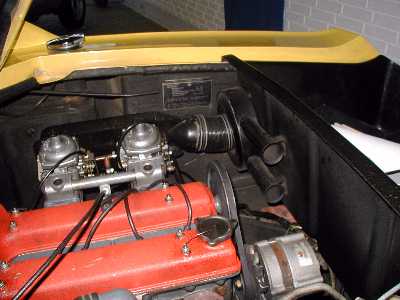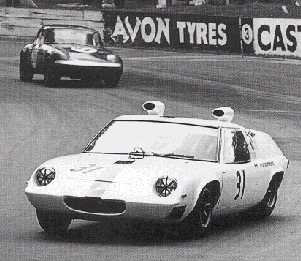Let's start with the power plot, so you don't have to scroll to the bottom all at once:

The power got a 10HP increase, the torque a 15Nm increase, the effect in the real world was
very nice too :-)
In theory...
It all started when I read an article by another 'Lotus Klub Danmark' member about the air
temperature's influence on engine power. To sum it up, cold air takes up lesser space than
hot air, so every step we can take to provide the engine with colder air means more power.
Also the air pressure around the intake is worth working with, to get more air through the
intake.
The power increases by:
0,22% per degree celsius the air is cooler, and
0,12% per mbar the pressure is increased.
The Europa is designed to have a low pressure area above the rear deck, pulling the hot air
out of the vents in the rear lid. I don't see any reason for the engine bay to be
pressurized from the bottom and there's no ram effect like on a front engined car. As a
consequense, the engine bay must also be at same or lower pressure as the surrounding air.
And - as anyone who has opened up to have a look at the engine after driving the car must
confirm - the temperature in the engine bay is a bit higher too.
Here is a photo of the engine bay as it used to look. The rusty thing beneath the air filter
is the exhaust damper. This should give a little clue as to where the story is going...

I didn't really know how to measure the air pressure, whereas the temperature could be
measured using a household termometer with a remote sender. So I made some measurements of
the air at various places around the engine, and came to the (somewhat surprising) result:
Outside air temperature: 20 C. Each test made with car in fifth gear at 90kph until
temperature reading was stable.
- 19 C temperature rise at the carbs next to the fuel T is, i.e. where the carbs would
draw air without the air box. (Don't worry about the plastic T, it's been replaced a long
time ago).
- 12 C temperature rise between the coil and the RH tank, i.e. at the bottom where I
suppose cold air enters the engine bay.
- 3 C temperature rise under the leftmost rear part (almost under the bumper).
- ... And now for the 'winner'... 24 C (!) temperature rise at the trumpets of the air filter.
Up until this point, I was planning to replace the original filter and flexible tubing with
a conical filter directly on the air box. This would be an easy task and also give the
benefit of an easily removable luggage tray. But the above measurements made me think that
plan over again more than once.
Another idea was to put on either one large or two small K&N style filters directly on the
carbs. A third idea was to modify the air box to draw cold air from the bottom of the
engine bay.
The good temperature measurement (+3 C) at the rear of the car, made me think in the
lines of some tube going across the engine bay, but the thought of the car having to breathe
through it made it not so appealing after all.
The snorkels used on some of the Type 47 race cars, was another probably very effectful idea,
but I found them a little too radical for me:

In practice...
In August of 2003 'Lotus Klub Danmark' was visiting the danish distributor of K&N
Filter's, Dot Engineering. They were planning to tell us
about the theory about the filters and the effect of feeding enough (and cool enough) air
to the engine. I was looking very forward to this visit, having had the thoughts above.
When we talked on the phone and they asked if they could borrow a Lotus and make some
before/after measurements on their dynometer, I couldn't think of a better car than my
own. Hey, I arranged the meeting, I ought to have some privileges, didn't I? :-)
The first thing they did was to get rid of the original filter. Apparently it was very
dirty, as I suspected, and with it the car had problems getting enough air. In fact the car
behaved so badly that they couldn't reproduce the results, above 3000 rpms. I had already
noticed this, but thought it was ignition faults or carbs running rich. I was
planning on checking up on it in the winter, together with the leak in the exhaust
manifold.
Having tried various setups and filters, they came up with the following solution:



First of all, the carbs now breathe through each own K&N filter directly at the carb intake.
Inside of the filter is a small carb throat, optimizing the air intake.
Secondly, the filters are protected from the hot engine bay by a heat insulating blanket.
The blanket is open at the top so that the vacuum above the rear lid can help move the air
past the filters.
Another way of getting cold air to the carbs is through the flexible tubes under the
filters. It's important to notice that the tubes don't ram air into the filters and
carbs. But they make sure that the filters are always surrounded by fresh cold air.
The tubes have a rubber edge protruding underneath the car. They look dramatically
low on the close up picture, but they are not thaaat low in reality.




I find the results very satisfying. At low revs the engine sound is a little less than
before. Above 3000 rpm it is somewhat higher. But it doesn't matter. And gone is the
stuttering at 4000-5000 rpm.
How much of the 10BHP increase comes from the colder air, how much from the easier breathing
and how much from the higher (unknown) air pressure?
I'm not sure, but according to the theory, the 24C*0,22%*90BHP gives appr. 5BHP increase.
Everyone should be able to achieve this with some flexible tubes. The revised intake and
filters are more a question of where in the rpm range the engine is optimized, and way
beyond my skills.
The ignition still needs a tune-up, and the carbs too (maybe more than before, due to the
revised intake). I hope this will result in another 10HP, making the car a really blast to
drive.
Parts list
I'm not sure whether these parts numbers are worldwide K&N numbers, or only for the danish
supplier, but here they come:
KN56-9155, K&N Filter bolt on, 150mm x 54mm (2x for the Strombergs)
KN85-5032, Ram Pipe DSS45/14 (2x for inside the filters)
KN62-1340, K&N Filter clamp on (for the crankcase ventilation tube)
One Powerblanket
Two Cool pipes
To the top...









